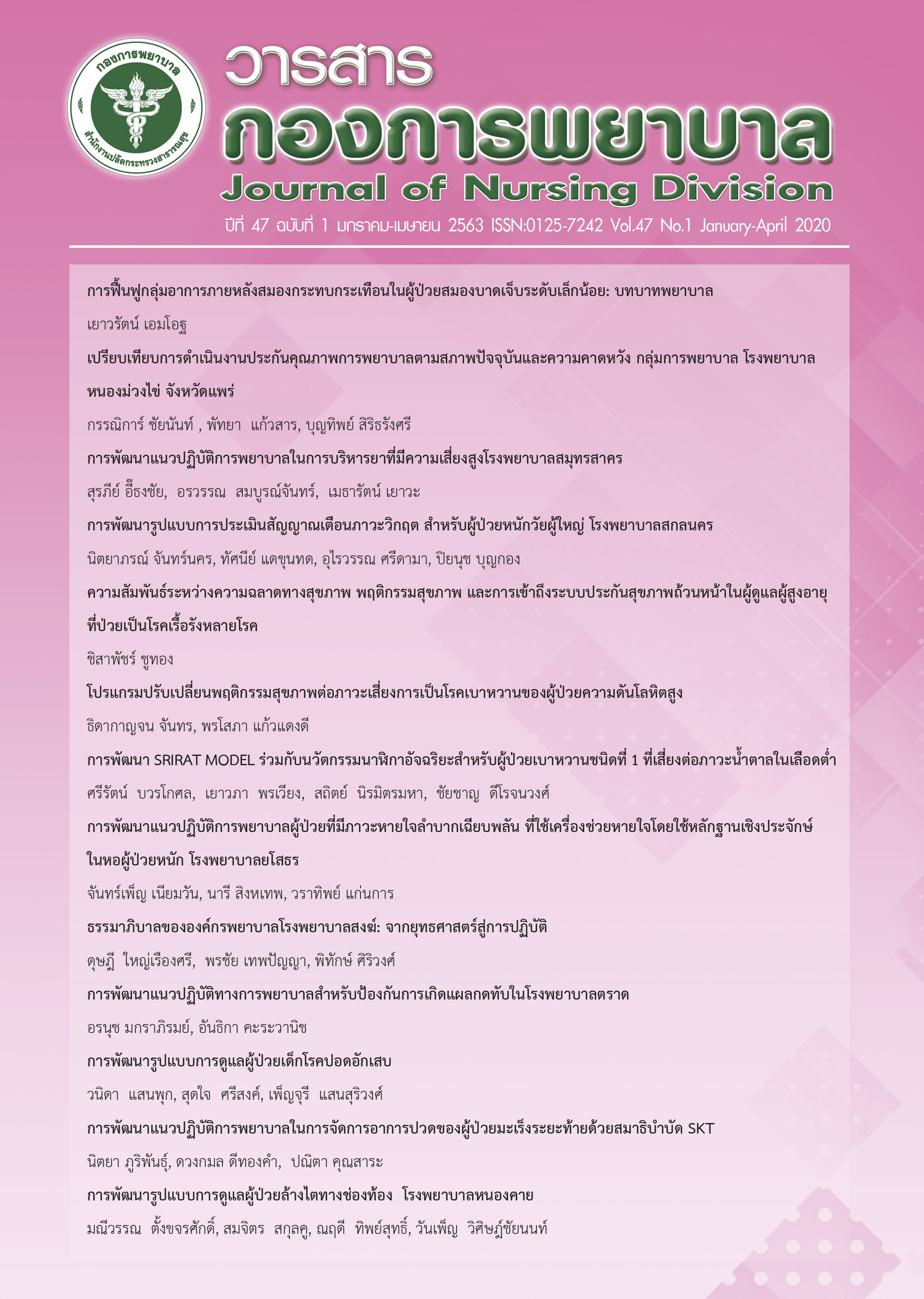โปรแกรมปรับเปลี่ยนพฤติกรรมสุขภาพต่อภาวะเสี่ยงการเป็นโรคเบาหวานของผู้ป่วยความดันโลหิตสูง
Main Article Content
บทคัดย่อ
โรงพยาบาลท่าหลวง พบผู้ป่วยความดันโลหิตสูงที่เป็นกลุ่มเสี่ยงเบาหวานเพิ่มขึ้น 739, 834, 863 ราย ในปี 2557, 2558 และ 2559 ตามลำดับ ซึ่งการป้องกันโรคเบาหวานในกลุ่มเสี่ยงสามารถทำได้โดยการปรับเปลี่ยนพฤติกรรมสุขภาพ ดังนั้น โรงพยาบาลท่าหลวงจึงทำการศึกษาผลของโปรแกรมปรับเปลี่ยนพฤติกรรมสุขภาพ ในผู้ป่วยความดันโลหิตสูงที่เป็นกลุ่มเสี่ยงเบาหวาน โดยมีวัตถุประสงค์ เพื่อเปรียบเทียบระดับน้ำตาลในเลือด น้ำหนัก และรอบเอวของผู้ป่วยความดันโลหิตสูงที่มีภาวะเสี่ยงต่อเบาหวาน ก่อนและหลังได้รับโปรแกรมปรับเปลี่ยนพฤติกรรมสุขภาพ วิธีการศึกษา คือ การวิจัยกึ่งทดลอง (Quasi- Experimental) แบบกลุ่มเดียววัดซ้ำ (one group pre-post test design) เลือกกลุ่มตัวอย่างตามเกณฑ์คัดเข้า จำนวน 33 คน ได้รับโปรแกรมการปรับเปลี่ยนพฤติกรรมสุขภาพเป็นระยะเวลา 6 เดือน ประกอบด้วย การสนทนาสร้างแรงจูงใจเพื่อปรับเปลี่ยนพฤติกรรมสุขภาพ การนับคาร์โบไฮเดรต การออกกำลังกายยางยืดเหยียด เก็บข้อมูลก่อนหลังโดยเจาะน้ำตาลในเลือด ชั่งน้ำหนัก วัดรอบเอว วิเคราะห์ข้อมูลโดยสถิติบรรยาย และ paired t-test
ผลการศึกษา พบว่า ผู้ป่วยโรคความดันโลหิตสูงที่เป็นกลุ่มเสี่ยงเบาหวาน จำนวน 33 คน หลังได้รับโปรแกรมปรับเปลี่ยนพฤติกรรมสุขภาพ เป็นระยะเวลา 6 เดือน ไม่เปลี่ยนไปเป็นผู้ป่วยเบาหวานรายใหม่ระดับน้ำตาล น้ำหนัก รอบเอว ลดลงอย่างมีนัยสำคัญทางสถิติที่ระดับ (p< .05) ดังนั้น โปรแกรมปรับเปลี่ยนพฤติกรรมสุขภาพในผู้ป่วยความดันโลหิตสูงที่มีภาวะเสี่ยงต่อเบาหวาน ที่เน้นการปรับเปลี่ยนพฤติกรรมเป็นแกนหลักสำคัญ สามารถช่วยลดจำนวนผู้ป่วยเบาหวานรายใหม่ในกลุ่มเสี่ยงได้อย่างมีประสิทธิภาพ
Article Details
เอกสารอ้างอิง
2. Delahanty LM, Grant RW, Wittenberg E, Bosch JL, Wexler DJ, Cagliero E, et al. Association of diabetes-related emotional distress with diabetes treatment in
primary care patients with Type 2 diabetes. Diabet Med J Br Diabet Assoc. 2007;24(1):48–54.
3. Aekplakorn W, Chariyalertsak S, Kessomboon P, Sangthong R, Inthawong R, Putwatana P, et al. Prevalence and management of diabetes and metabolic risk
factors in Thai adults: the Thai National Health Examination Survey IV, 2009. Diabetes Care. 2011;34(9):1980–5. Thai.
4. Bock G, Man CD, Campioni M, Chittilapilly E, Basu R, Toffolo G, et al. Pathogenesis of Pre-Diabetes: Mechanisms of Fasting and Postprandial Hyperglycemia in
People With Impaired Fasting Glucose and/or Impaired Glucose Tolerance. Diabetes. 2006;55(12):3536–49.
5. American Diabetes Association. Diagnosis and Classification of Diabetes Mellitus. Diabetes Care. 2014;37(Supple 1):S81–90.
6. Critchley CR, Hardie EA, Moore SM. Examining the psychological pathways to behavior change in a group-based lifestyle program to prevent type 2 diabetes.
Diabetes Care. 2012;35(4):699–705.
7. NCDs.pdf. [Internet].2017 June [cited 7 Aug 2019]. Available from: https://www.dmh.go.th/ebook/files/ncds.pdf
8. The Diabetes Association of Thailand and The Dietetic Association of Thailand.Carbohydrate counting for health and diabetes control. 1st ed. Bangkok:
Concept Medicus Company Limited; 2017. Thai.
9. Irvine C, Taylor NF. Progressive resistance exercise improves glycaemic control in people with type 2 diabetes mellitus: a systematic review. Aust J
Physiother.2009;55(4):237–46.
10. Intarawichian S. Changing Health behavior by participate to sustainable, in the diabetes mellitus risk group, Kasetwisai district: Roi-et province. Journal of the
office of dpc7 khon kaen. 2012;19(2): 65-75. Thai.
11. Bandura1994 EHB.pdf [Internet]. [cited 7 Aug 2019]. Available from: https://www.uky.edu /~eushe2/Bandura/Bandura1994EHB.pdf
12. Terdsak Dechkong. Motivation Interviewing for NCDs: A MI NCDs 1st ed. Bangkok: Beyond
Publishing;2017


